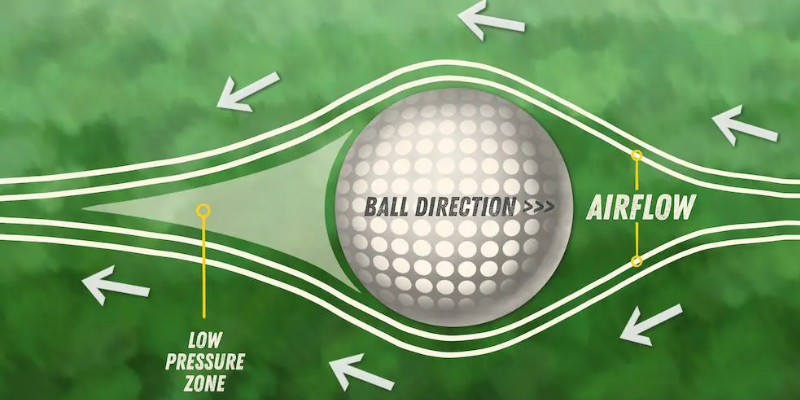Many golfers, whether they have been playing for a long time or just started, often want to know about how many dimples on a golf ball; it seems like an easy question but the answer is not so straightforward.
We respond to that question and explain all the details you must understand regarding the dimples on a golf ball.
Golf Ball Dimples Number?
Actually, the number of dimples on a golf ball is not fixed. It changes with different models and who makes them. The most common number is between 300 and 500 dimples.
The 2017/18 version of the well-known Titleist Pro V1 ball includes 352 dimples, and the other main ball from Titleist in that year, named Pro V1x, contains 328 dimples.
For a certain producer, the solution to the number of dimples on a golf ball was an impressive total of 1,070, which holds the record.
Why Do Golf Balls Have Dimples?
Manufacturers of golf balls add dimples not for appearance but based on actual scientific reasoning. When an object that is not smooth or has uneven shapes flies, the way air moves over it causes its path to change a lot.
Therefore, golf balls if they don’t have small holes on them will move in ways we cannot expect when they are hit through the air. Golfers would have little hope controlling a smooth golf ball.

When you put dimples on a golf ball, it makes a small air layer around the ball that really reduces drag. This causes the air to move over more of the ball’s surface, leading to much steadier flight for the ball. It seems that the science of dimples is useful not only for golf balls but also it can be applied to cars.
Golf balls are designed with dimples to help them rise up in the air. A backward spin on the ball can contribute to as much as fifty percent of this lifting effect. When the ball rotates in reverse, the air below has higher pressure compared to above, causing the ball to go up. Small indentations increase this outcome and they add half of total upward force.
How Big Are Dimples on Golf Balls?
The depth of dimples on golf balls is usually what people measure. On average, the depth of these dimples is about 0.010 inch. The size around dimples can change depending on the model. Although many dimples are round, they are not required to be so. Callaway’s HX ball has hexagon-shaped dimples, for example.
Arrange golf ball dimples symmetrically, ensuring they fit within specific size and depth limits.
Does it Matter to me How Many Dimples in a Golf Ball?
Earlier we mentioned that golf balls have a different number of dimples depending on the model and who makes them. Also, each type of golf ball has its own size of dimples and a unique pattern for these dimples.
Which pattern of dimples should you choose? Actually, it’s not necessary for you to understand which dimple pattern suits you or the specific dimple design on a golf ball. It’s best to leave that decision in the hands of the golf ball creators.

Concentrate on the characteristics of how the golf ball performs. Understanding whether a ball gives you high or low launching ability, or if it offers much spin or very little spin.
The characteristics of a golf ball, such as how it flies or rolls, come from the pattern and size of the dimples on its surface. However, one should focus more on how well the ball performs rather than just looking at its dimple design.
When Did Golf Balls Get Dimples?
Golfers discovered the dimples on golf balls by chance. Around the mid-1800s, they commonly used a type of golf ball called a guttie, made from shaped tree sap and first developed by Robert Adams Paterson.
When players of golf noticed their balls getting marks and scratches, they saw that these used ones flew more predictably compared to the brand-new, perfect ones.
Following that finding, producers of golf balls started to carve out raised bumps onto the surface. Then in the early 1900s, a different inventor realized that golf balls with dimples worked much better than those with the bumps.
In 1905, William Taylor from England got a patent for the design of dimples on a golf ball. Not much time passed before every golf ball had dimples which we would still recognize now.
With advancements in ball technology, the study of dimple designs has also improved. Nowadays, we use sophisticated machines to test different patterns of dimples to discover which one is best for flying far and being easy to control.
Conclusion
Learning about how many dimples on a golf ball gives ideas into the science behind this sport.
Even though the number of these dimples can change, often between 300 and 500, they all have one job: to make better air flow so that golf balls can travel farther and with more precision.
This discovery by chance, improved with technology, shapes contemporary golf.
So when you play next and start at the tee, recognize how the small dimples help in making your game better.
F.A.Q
How many dimples are on a golf ball❓
The number of dimples can vary, but it typically ranges from 300 to 500 dimples.
Why do golf balls have dimples❓
Dimples on golf balls help reduce air resistance and increase lift, allowing the ball to travel farther and more accurately.
Do different golf balls have different numbers of dimples❓
Yes, different golf ball manufacturers may use varying numbers and patterns of dimples to achieve different flight characteristics.
How are dimples on a golf ball arranged❓
Manufacturers usually arrange dimples in a symmetrical pattern across the surface of a golf ball.
Do smaller dimples make a golf ball go farther❓
Smaller dimples can create less drag, potentially allowing the ball to travel farther, but the overall design and construction of the ball also play a significant role.